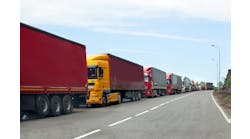Managing movement of assets on a vast scale in a business that changes from minute to minute is daunting. Keeping up and adjusting to those changes based on observations and communications from the people in the field requires a great deal of human interaction with sophisticated technology. This is transportation management on the fly, reacting and adjusting to real time events.
The product to be moved usually sits away from pavement, in rural areas often reached by two-track roads. The product is crude oil pumped up from the ground, put into tanks on site, and then into a truck that moves it to the nearest pipeline. The company moving the oil is Plains All American Pipeline, L.P., the largest transporter of oil and gas in North America, according to Mickey Masters, dispatch manager of the company’s Southwest Division. Plains has four divisions for its oil and gas business.
With headquarters in Houston, the company handles 3 million barrels a day of crude oil, refined products and liquefied petroleum gas. Masters explains that Plains is in the transportation and marketing business. “One company will drill. They will drill for a production company that acquired the lease of the land. Then another company will produce the oil. They will put it into tanks. Once it’s in a tank we buy it from them on the leased land. Then we take the oil to one of our stations, put it into a pipe and sell it.”
The pipelines transport oil from a Plains storage facility to a market—a refinery or another Plains storage facility. Occasionally, if there’s enough production to warrant it, the company might run smaller pipes. “If there’s not,” says Masters, “then we basically have a mobile pipeline, which is a truck.”
Drivers for Plains do more than just pick up and deliver their loads. Using the truck’s power take-off equipment drivers must check the quality of the oil on location to make sure it’s merchantable. If not, the load will be refused. Drivers check things like the gravity of crude oil, its temperature and how dirty it is by using equipment on the truck. If the crude meets the company’s criteria, it’s put in the truck and moved to an unloading station where it’s injected into a pipeline.
In order to keep up with the variables that occur during a day, Plains relies on the insight and experience of its drivers and XATANET fleet operations on-demand software. A XATA Corp. offering, the solution provides the ability to maintain communications via 802.11, cellular or satellite. “We go places where there’s no cell coverage,” notes Masters, “so satellite communications is a big plus for us. If something goes wrong, we know almost instantly. Also, with the email capability, drivers can email us if they can’t get out on a cell phone.”
Before going with the more automated solution, Plains was using an older obsolete system, according to Masters. When Plains bought Link Energy it found the acquisition was employing XATA software that was far superior to what Plains was using. Instantaneous feedback the solution provides was a strong reason for the choice.
“We have a separate piece XATA built for us,” explains Masters. “On top of the regular product we use a hand held computer. We have a dispatch system used to push trip information. XATA sends data to us. We feed it into our dispatch system. Then we break it back out, write and print tickets for the truck, and then transmit the information to the driver via the XATA system. Because of our dispatch program we are able to put directions in and send that as part of a driver’s trip.”
It is with driving directions that the human element plays a big part. With so much truck loading in rural areas not covered in currently available GPS mapping systems—they don’t cover twotrack roads—knowledge of terrain and landmarks for individual wells is critical. “There are so many variables in what we do that technology doesn’t help,” says Masters. “We do get a big piece of the puzzle but there’s always the human element that we can’t get away from. Some producers will not let you in until a certain time. Some want you there at night, others only during the daytime, for example.”
At an opposite pole from Plains in its need for transportation management is Pella Corp., a leading provider of quality windows and doors. Where Plains is dealing with a daily dose of real time variation, Pella is able to leverage its transportation management in a more fixed fashion to remain an extremely lean manufacturer.
The company makes use of Oracle’s Transportation Management 5.5 solution to handle a complex supply chain network. Pella has a number of different US production sites that serve many end point customers across the country. In describing the challenges to be met by the solution Derek Gittoes, Oracle’s vice president Logistics Products Strategy, explains that Pella runs multiple cross dock facilities where, among other things, orders that are going to the same customer but are coming from different production sites are married into a single delivery. This is accomplished at a handful of strategically located cross docks across the country. Doors are made in one factory, windows in another. The customer doesn’t want two trucks showing up for one order.
Before selecting the program Pella was using a legacy load planning module that in turn depended on an unsupported, obsolete operating system. Because the company had found success in its use of Oracle’s E-Business Suite, it looked to the supplier’s Transportation Management 5.5 as an automated, integrated platform to streamline planning and logistics.
Peter Genheimer, Pella IT Supply Chain manager, says, “As we set out to manage our outbound shipping with Oracle, we needed to be able to achieve our IT goals without incurring cost penalties while maintaining our commitment to on-time delivery and customer satisfaction.”
Pella does not produce a window or door until it has an order. While many manufacturers keep an item master for 5-10,000 products, there are so many options for Pella that basically every product that’s created is unique. Generally, from the time it takes an order to when that order is produced and shipped is only a few days. Gittoes notes that the company is one of the leaders in practicing lean processes for manufacture and supply chain.
Most shipments for Pella are not full truckload going to a particular customer, even after windows and doors have been combined for the one shipment. The manufacturer makes use of less than truckload (LTL) pools. A typical shipment may go from a factory to a cross dock where it joins with other products. It then goes to a consolidation center run by a local LTL carrier that handles the final delivery.
“There is a lot of consolidation and deconsolidation planning that has to go on in order to move products from factory to end destination,” explains Gittoes. “They do that for service—since the customer doesn’t want multiple shipments—and to drive down freight costs. Any particular truck may move upwards of 10 or 20 orders.”
Other motivation for Pella in choosing 5.5 was to increase the level of decision support and to get rid of inefficiencies— things like the manual planning of what the manufacturer refers to as “shuttlemovements,” the trailers that come from the factory to the cross dock—and to increase carrier collaboration. Previously Pella was printing reports and faxing them as opposed to a more automated and streamlined communication process with their carrier base.
“Working with Oracle, we were able to design an automated solution that keeps our trucks filled and running on schedule while reducing manual processes in our outbound planning operations,” says Genheimer.
“One of the things we help them with,” explains Gittoes, “is if they have a truck coming to the cross dock with product that is going to be combined with other freight and shipped out together, we help planning of the trailer load so that product is at the front as it arrives. Other shipments are taken off the back of the trailer and then the trailer is re-loaded with the additional freight, keeping the original material in place. It’s called nose loading and we help plan for that. Time is saved and with less handling there is less chance of damage. This was all planned manually before.”
In observing the functionality of the solution, Pella’s logistics manager, Steve Bowers, observes that, “Since deploying Transportation Management 5.5 we have significantly reduced the need for manual involvement in our load planning operations.”
Within 5.5 is an optimization capability Oracle terms “cooperative routing.” The feature permits the shipper to look at its entire network to determine if there are flows or lanes that would make sense to bundle as one unit of work.
A focus for Oracle is the relationship between shippers and carriers. “One thing we’ve done,” claims Gittoes, “is to build out automatic dock scheduling for pickup and delivery appointments and to have them confirmed and conveyed to the carrier. The idea is that they will have some confidence that they’re not going to have to park on the street and wait three hours.” The schedule is provided on line and helps both the shipper and carrier to optimize operations.
“We’ve gained greater confidence in the reliability and scalability of our system,” says Bowers. “We anticipate that we’ll see noticeable benefits to our load planning labor efficiencies and are prepared for increased growth in the years ahead.”


